Woman’s “Terrible Headache” Turns Out to be a Life-Threatening Brain Bleed
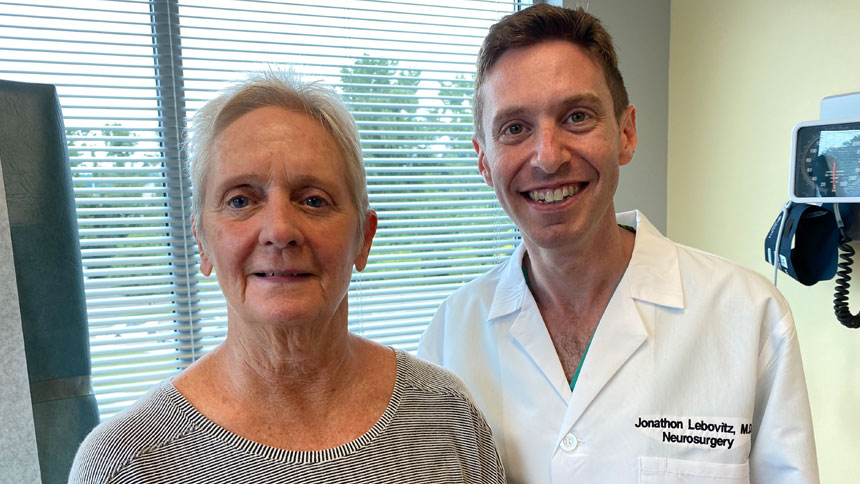
08/02/2021
Karen Smith-Gattuso had emergency surgery to treat a ruptured brain aneurysm
Karen Smith-Gattuso has had no major health concerns and has never been in an ambulance or hospital as a patient during her 69-year old life. She also never takes medication. It was particularly unusual for her to feel unwell and alarming to have a “terrible headache” that would not go away. She dialed 9-1-1.
Emergency treatment for a ruptured brain aneurysm
Karen had the wherewithal to text her cat sitter and unlock her front door for emergency medical services before laying down on her bed — the last thing she remembers before waking up in the intensive care unit (ICU).
Karen later learned the ambulance took her to Nuvance Health’s Danbury Hospital Emergency Department where she had a CT scan and a CTA scan — a type of imaging used to evaluate and diagnose blood vessel conditions, such as aneurysms or blockages.
The imaging revealed an aneurysm — a bulging or weakening of an artery wall — had ruptured and was causing bleeding in her brain.
Karen had a subarachnoid hemorrhage (SAH), which is a type of stroke and life-threatening medical emergency. Bleeding from a damaged artery at the surface of the brain usually causes a sudden and severe headache. It can cause permanent brain damage or death if not treated quickly.
Dr. Jonathon Lebovitz was on the scene.

Dr. Jonathon Lebovitz, Neurosurgery
Dr. Lebovitz is a fellowship-trained neurosurgeon who specializes in cerebrovascular neurosurgery and treating conditions involving blood vessels of the brain and spinal cord. He offers patients minimally invasive techniques to aid in faster recovery including advanced transradial (through the wrist) neurointerventions.
Karen later learned that Dr. Lebovitz spoke with her niece, who is her emergency contact. He recommended treating Karen with a transradial intervention, which meant stabilizing and transporting her to Nuvance Health’s Vassar Brothers Medical Center.
Karen’s aneurysm had two lobes with bulging domes (the rounded area of the aneurysm). Dr. Lebovitz guided a catheter over a tiny wire through an artery in Karen’s wrist to the aneurysm in her brain. He was able to coil the wire inside the larger dome to form a clot and completely stop blood flow.
The opening from the artery to the second lobe of the aneurysm was too large compared to the size of the dome for coiling.
A second procedure was required but after Karen was stable and on blood thinners. Using the transradial approach again, Dr. Lebovitz fully treated the aneurysm by placing a stent across the opening of it to divert blood flow away from it.
Recovering from serious brain trauma
Karen was in the ICU for three weeks after surgery, which is standard for SAH patients. She recalled that she slept in intervals. Then finally, during the last week, she was able to get up and walk.
“The nurses were really nice and helped me walk around the ICU,” said Karen. “It was a great experience.”
Karen said she felt “a little weak” but “mostly fine” when she left the hospital.
She is thankful for her neighbors and in-home nursing and therapy.
“I have wonderful neighbors who went grocery shopping for me and checked in with me often. They kept my spirits up and helped me recover,” said Karen.
A physical therapist came to Karen’s home once a week, although she was mobile and did not have any major deficits. Her main problem was piriformis syndrome, which causes spasms and pain in the glute muscle and sciatic nerve pain, numbness and tingling along the back of the leg and into the foot.
Karen also had outpatient physical therapy and learned new ways to stretch and keep her body balanced.
She felt back to normal about a month after surgery and continued to stay well.
Karen had a six-month follow-up angiogram — imaging of the inside of the blood vessels — at Danbury Hospital and said, “Everyone was nice in the catheterization lab and made me feel like I did not need to worry. It was fascinating because I was awake during the whole procedure and could watch everything on the monitors.”
Feeling “great”
Today, Karen said she “feels great.”
“I do not remember the last time I needed to take medicine for a headache,” said Karen.
Karen — who has a second-degree black belt in martial arts — is back to her gym workouts, bike riding and rowing. She is also back tending to her flower and vegetable garden.
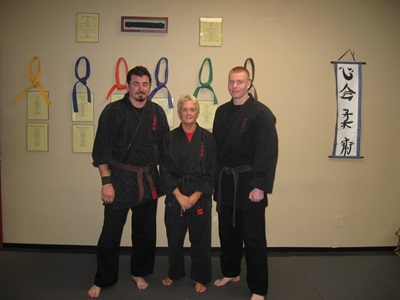
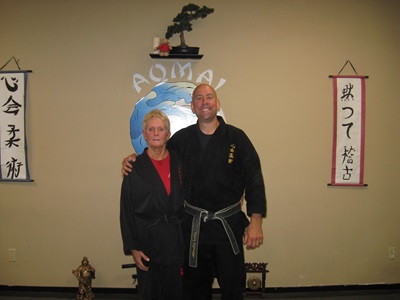
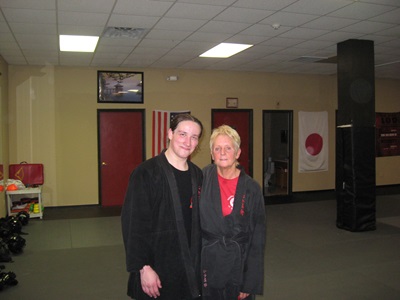
Karen Smith-Gattuso has a second-degree black belt in martial arts
Karen is also back to loving life in Heritage Village in Southbury, Connecticut, which she said is conducive to her active lifestyle and “in a beautiful area on top of a mountain with a nature preserve view.”
Karen retired from a corporate career in 2016 and since then has taught group fitness, which is something she “fell in love with.” She is continuing to help others also live a healthy lifestyle.
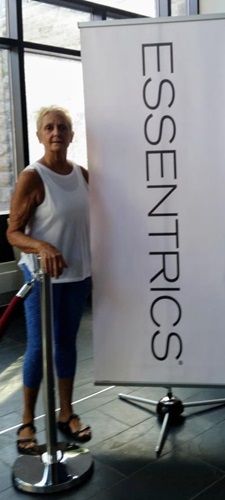
Karen Smith-Gattuso
“I am very thankful that I am still here, thanks to Dr. Lebovitz. He made it easy for me to be a patient. He is compassionate and such a good person,” said Karen.
“It is important to provide personalized care to each patient when treating any neurosurgical condition from degenerative spine, trauma or cerebrovascular disease,” said Dr. Lebovitz. “I show my patients their imaging and use models or drawings to ensure they understand and are comfortable with the treatment plan.”
Dr. Lebovitz continued, “It is also important for my patients to know we are a team combating their neurosurgical problem. We have a shared goal to help them feel better and will work towards winning together.”
Dr. Lebovitz attributes Karen’s speedy recovery from a serious brain trauma to quick intervention and her overall good health.
“There are grades of subarachnoid hemorrhage patients from 1 to 5, with 5 being in a coma. Karen was a grade 2. She thankfully did not get very sick at the beginning and had an overall great outcome,” said Dr. Lebovitz.
“Do not take life for granted”
Karen is sharing her story in case it helps others to live their lives to the fullest.
Karen jokes, “The best genes I have are in my closet.” However, committing herself to a healthy lifestyle was no joke. Most relatives on her mom and dad’s side of the family died from cancer or heart disease when they were in their 60s and 70s.
“About 30 years ago, I made a pact with myself to stay as healthy as possible and live longer than they did,” said Karen.
Karen has stayed true to her commitment and said she has “lived a very healthy life.”
She eats healthy meals and likes the outdoors and hiking at state parks in particular.
“I could have expected another diagnosis because of my family history. But a brain bleed was a surprise,” said Karen. “You never know what can happen. Do not take life for granted.”
“I believe movement is medicine and that is my motto. I keep moving to go forward,” said Karen.
Most people describe the hemorrhage of a ruptured brain aneurysm as the worst headache of their life. Even people who have chronic headaches describe the headache they had from a ruptured aneurysm as different and more severe. Some people may also experience stroke symptoms or neck pain.
The outcome of treatment for a subarachnoid hemorrhage varies from person to person. No individual results should be seen as typical.
About Dr. Jonathon Lebovitz
Jonathon Lebovitz, MD is a fellowship trained neurosurgeon at Neurosurgical Associates of Southwestern Connecticut. In addition to providing comprehensive treatment in all aspects of neurosurgery, he specializes in the treatment of complex cerebrovascular disease including aneurysms, vascular malformations and acute stroke.
Dr. Lebovitz offers conservative and advanced surgical treatments of complex spine and cranial abnormalities including trauma, tumors, and hemorrhage. He utilizes minimally invasive techniques to perform spinal decompressions, spinal fusions, brain and spinal cord tumor treatments, and intracerebral hemorrhage evacuations.
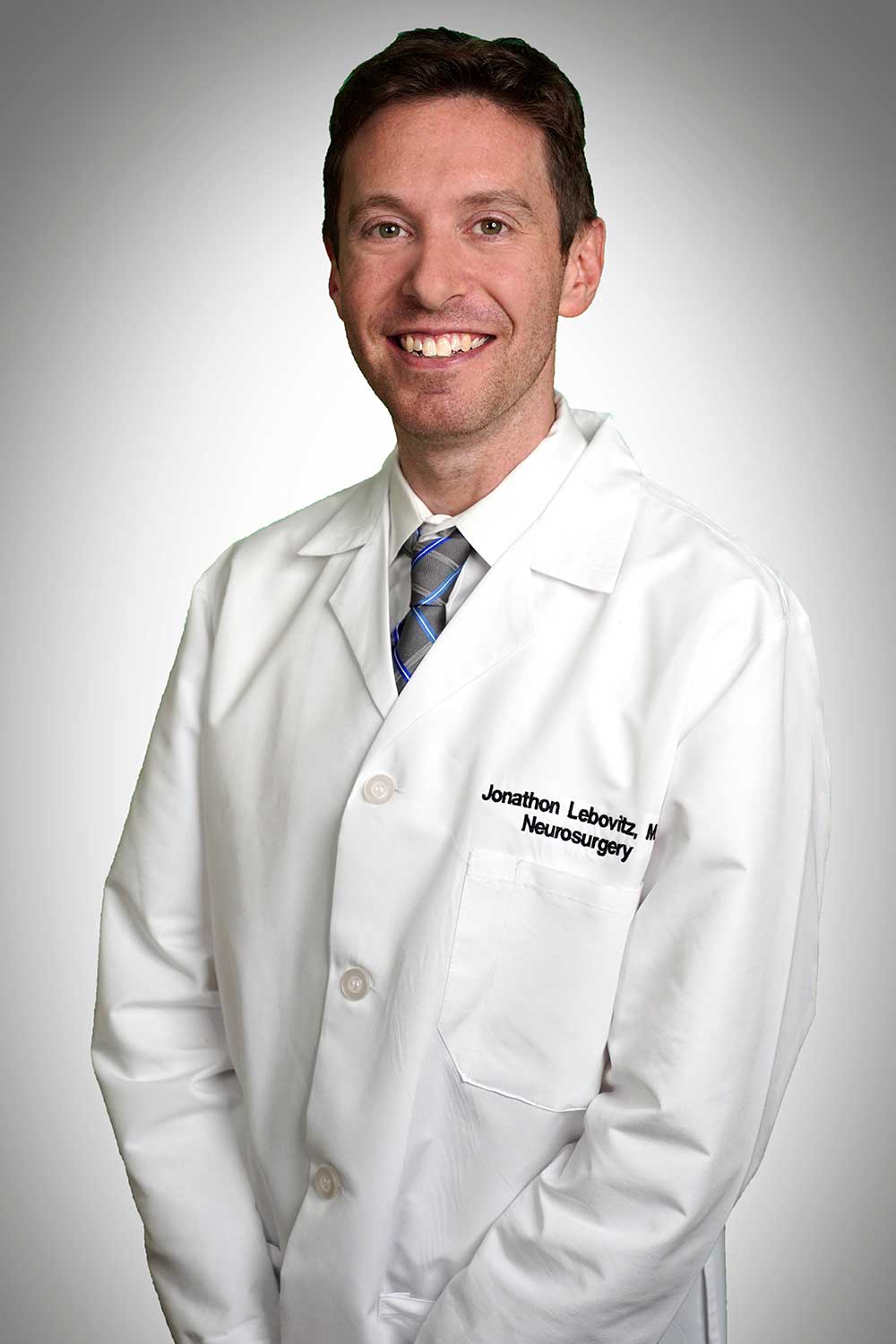
Recent News
Man Feels “Lucky” Brain Aneurysm was Found and Treated Without it Rupturing
Man Feels “Lucky” Brain Aneurysm was Found and Treated Without it Rupturing 08/19/2021 Unruptured brain aneurysms may have no symptoms until they burst and cause a life-threatening medical emergency Milton Reyman, a 66-year old from New Milford, Connecticut, felt...
Dad Dances All Night at Daughter’s Wedding After Spine Surgery
Dad Dances All Night at Daughter’s Wedding After Spine Surgery 08/10/2022 William Green had excruciating pain and could barely walk from a lower back injury William Green, 64, had terrible pain from his lower back shooting down his left leg. It was affecting his...
Woman With Cancer Bounces Back After Two Spine Surgeries for Herniated Disc and Bone Spur
Woman With Cancer Bounces Back After Two Spine Surgeries for Herniated Disc and Bone Spur 02/21/2023 Nuvance Health neurosurgeon designs the least invasive spine surgeries possible due to Randi Rote’s history of multiple myeloma, spinal stenosis and a life-threatening...
Two-Year-Old Narrowly Survives Emergency Brain Surgery During COVID-19 Pandemic
Two-Year-Old Narrowly Survives Emergency Brain Surgery During COVID-19 Pandemic 03/29/2021 The list of things scarier than a pandemic caused by an unknown virus is short. For Claire and Mark, on that list is their two-year-old son undergoing emergency surgery for a...
Cancerous Brain Tumors Finding Shocks Woman Whose Husband Also has Brain Cancer
Cancerous Brain Tumors Finding Shocks Woman Whose Husband Also has Brain CancerNorwalk, Connecticut, August 26, 2021 — After 49 years of marriage, Jayne Davis said, “My husband Frank and I are like mac and cheese. Not the same, but similar.” This oddly rang true when...
Twenty-Two Year Old Stroke Patient from Norwalk Hospital Makes Full Recovery
Twenty-Two Year Old Stroke Patient from Norwalk Hospital Makes Full RecoveryNORWALK, Connecticut, October 17, 2018 — Twenty-two year old Sawyer Gaines suddenly couldn’t move his right arm. He was light headed, and felt like he was drifting away. He knew something was...